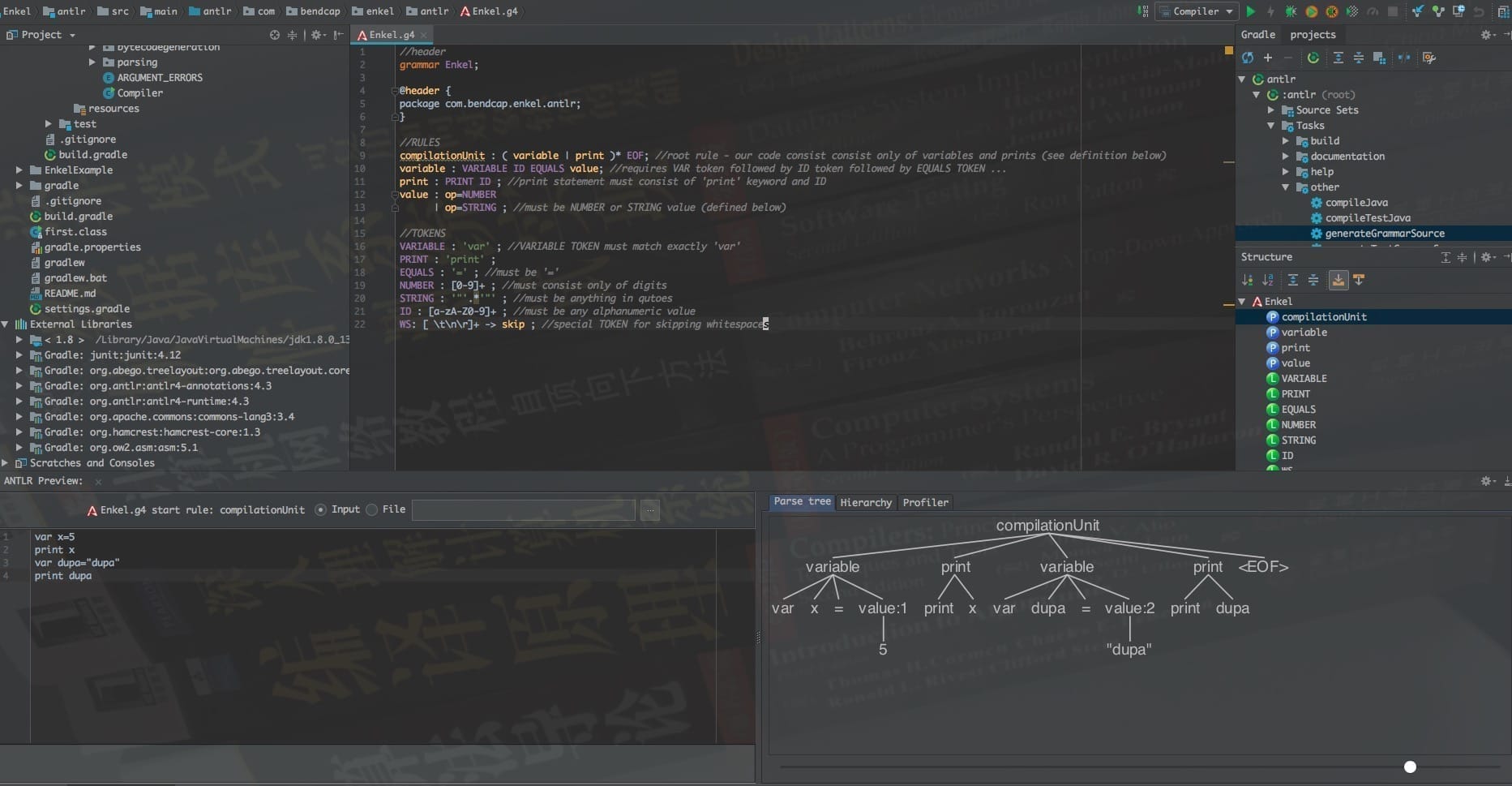手把手教你实现一门运行在 JVM 上的语言 Enkel, 系列 3
/ / 点击 / 阅读耗时 23 分钟本文系 Creating JVM language 翻译的第三篇。
0. 自顶向下的方式
开发一门语言不是短期任务,我将以自顶向下的视角来开发。为了避免陷入每个模块的实现细节,我准备先宏观的描述每个模块,然后在每个迭代,我将慢慢加入更多的细节加以完善。
1. 代码
作者原来的代码是 Maven 工程,译者这里改成了 Gradle(译者熟悉 Gradle 并且觉得更为优雅),目录结构以及包名也做了些许改动,但是逻辑上都是等价的。
读者可根据喜好,自行选择。
约定:每个章节,涉及到代码变更,译者都会打 tag, tag 的名字和章节名字保持统一,比如,当前章节的代码版本是 PART-3,以此类推。
2. 功能
本章节我将为 Enkel 添加如下功能特性:
- 声明
int或者string类型的变量 - 打印变量
- 简单的类型推断
示例如下:1
2
3
4
5//first.enk
var five=5
print five
var dupa="dupa"
print dupa
下面我们将实现能最简化版本,让上述代码可以运行在 JVM 上。
3. 用 ANTLR4 实现词法分析&语法分析
从零开始实现一个词法分析器是重复性很强的劳动。这里使用 Antlr (Antlr 4)实现。你需要做的只是创建一个语法规则文件,Antlr 帮你生成可以遍历 AST 的基础代码。
本章语法规则文件为 Enkel.g4:1
2
3
4
5
6
7
8
9
10
11
12
13
14
15
16
17
18
19
20
21
22//header
grammar Enkel;
@header {
package com.bendcap.enkel.antlr;
}
//RULES
compilationUnit : ( variable | print )* EOF; //root rule - our code consist consist only of variables and prints (see definition below)
variable : VARIABLE ID EQUALS value; //requires VAR token followed by ID token followed by EQUALS TOKEN ...
print : PRINT ID ; //print statement must consist of 'print' keyword and ID
value : op=NUMBER
| op=STRING ; //must be NUMBER or STRING value (defined below)
//TOKENS
VARIABLE : 'var' ; //VARIABLE TOKEN must match exactly 'var'
PRINT : 'print' ;
EQUALS : '=' ; //must be '='
NUMBER : [0-9]+ ; //must consist only of digits
STRING : '"'.*'"' ; //must be anything in qutoes
ID : [a-zA-Z0-9]+ ; //must be any alphanumeric value
WS: [ \t\n\r]+ -> skip ; //special TOKEN for skipping whitespaces
语法规则很简单,需要注意的是:
- EOF - 文件结束
- 语法规则中的空格和
;是必须
Enkel.g4 定义好后,可以运行命令来生成后续需要的 Java 代码:antlr Enkel.g4
命令执行完后,会生成四个类:
- EnkelLexer - 包含 Token 相关信息
- EnkelParser - 解析器,Token 信息以及一些内部类来做规则解析
- EnkelListener - 当访问语法节点的时候,提供回调函数
- EnkelBaseListener - 空的 EnkelListener 实现
译注: 如果你使用 Gradle 工程的话,可以使用 ./gradlew :antlr:generateGrammarSource 来生成上述代码。
其中最重要的是 EnkelBaseListener,这个类提供了遍历 AST 时的回调函数,我们不用关心词法分析和语法分析,Antlr 帮助我们屏蔽了这个过程。
我们可以使用 javac *.java 编译上述代码,来测试我们的规则正确性。
1 | $ export CLASSPATH=".:$ANTLR_JAR_LOCATION:$CLASSPATH" |
上述输入会生成如下的图形化树形结构(抽象语法书的图形化展示):
译者注:可以使用 IDEA 插件 ANTLR 4 grammar plugin 来实现同样的效果,或许更方便一些。
4. 遍历语法树
EnkelListener 提供了我们遍历语法树的办法。
1 | EnkelTreeWalkListener.java |
getInstructionsQueue 按照代码顺序返回指令。
下面我们可以注册 Listener:
1 | SyntaxTreeTraverser.java |
这里我提供了另一个 Listener 来做异常处理:
1 | EnkelTreeWalkErrorListener.java |
遍历语法树的 Listener 写完后,我们来测试一下。创建 Compiler 类作为入口,输入参数为我们 Enkel 语言的源文件路径。
1 | //Compiler.java |
下面我们既可以验证我们的 *.enk 文件了。目前的实现很简陋,但是可以做如下事情:
- 允许用
var x=1或者var x = "anthing"来声明变量 - 允许用
print x打印变量 - 如果语法不符合规则,报错提示
下面我们创建示例 first.enk:1
2
3
4var five=5
print five
var dupa="dupa"
print dupa
验证:
1 | $java Compiler first.enk |
在 first.enk 最后添加一行 void noFunctionsYet(), 再次验证,ErrorListener 可以检测到错误,并且输出如下提示信息:1
2You fucked up at line 1,char 0 :(. Details:
mismatched input 'void' expecting {<EOF>, 'var', 'print'}
5. 根据 instructions queue 生成字节码
Java 的 class 文件的包含的指令描述参见 JSE 文档。每一条指令包含如下结构:
- 操作符(1 byte)- 指令
- 可选的操作数 - 指令的输入
例: iload 5 (0x15 5),从局部变量加载数据,5 是局部变量数组的索引。
指令也可以实现操作数占的出栈入栈操作。
例如:
1 | iload 3 |
上述代码分别从局部变量数组中加载索引为 3 和 2 的变量,此时栈中包含两个数值,iadd 指令将栈中两个出栈,相加,然后结果再次入栈。
6. ASM
这里选用 ASM 来操作 Java 字节码。这样可以不用关心非常底层的十六进制数字,你只需要知道指令的名字,ASM 会自动帮你处理剩下的事情。
7. Instruction interface
SyntaxTreeTraverser 在遍历 AST 的时候会把指令按照顺序存储到 instructionsQueue 中。我们做一次抽象,定义接口 Instruction:
1 | public interface Instruction { |
接口的实现需要使用 MethodVisitor(ASM 提供的类) 来做一些代码生成的操作。
1 | //Compiler.java |
由于目前 Enkel 不支持 方法,类以及作用域等概念,因为编译后的类直接继承自 Object, 包含一个 main 函数。MethodVisitor 需要提供局部变量以及栈的深度。然后我们遍历 instructionQueue 的每条指令来生成对应的字节码。目前我们只有两种指令(变量声明以及打印语句):
1 | //VariableDeclaration.java |
这里值得注意的是,我们已经添加了简单的类型推断。我们会根据变量的实际类型进行类型推断。针对不同类型我们需要调用 ASM 不同的方法:
- visitInsn - 第一个参数是操作符,第二个是操作数
- BIPUSH - 把一个 byte(integer) 入栈
- ISTORE - int 类型的值出栈,并存储到局部变量中,需要指定局部变量的索引
- ASTORE - 和 ISTORE 功能类似,但是数据类型是索引
打印语句的代码生成如下:
1 | //PrintVariable.java |
- GETSTATIC - 从
java.lang.System.out获得静态属性,类型是java.io.PrintStream - ILOAD - 把局部变量入栈,id 是局部变量的索引
- visitMethodInsn - 访问方法指令
- INVOKEVIRTUAL - 触发实例方法 (调用 out 的 print 方法,该方法接受一个参数为整数类型,返回为空)
- ALOAD - 和 ILOAD 类型,但是数据类型是引用
8. 生成字节码
cw.toByteArray(); 执行后,ASM 创建一个 ByteVector 实例并把所有的指令加入进去。Java class 文件的结构为:
1 | //https://docs.oracle.com/javase/specs/jvms/se8/html/jvms-4.html#jvms-4.1 |
魔数(Magic Number)是 0xCAFEBABE。由于 Enkel 目前不支持字段,属性,父类或者接口,因此我们这里主要描述了 method_info。
9. 写入字节码到文件
JVM 规范要求我们 .class 文件的名字必须和类型相同。所以我们这里保持文件名字和类名一直,仅替换后缀 (enk -> .class)。1
2
3
4
5
6
7//Compiler.java
private static void saveBytecodeToClassFile(String fileName, byte[] byteCode) throws IOException {
final String classFile = StringUtils.replace(fileName, ".enk", ".class");
OutputStream os = new FileOutputStream(classFile);
os.write(byteCode);
os.close();
}
10. 验证字节码
我们可以使用 JDK 自带的 javap 工具来验证生成的字节码的正确性。1
2
3
4
5
6
7
8
9
10
11
12
13
14
15
16
17
18
19
20
21
22
23
24
25
26
27
28
29
30
31
32
33
34
35
36
37
38
39
40
41
42
43
44
45
46
47
48
49
50
51
52
53
54$ $JAVA_HOME/bin/javap -v file
Classfile /home/kuba/repos/Enkel-JVM-language/file.class
Last modified 2016-03-16; size 335 bytes
MD5 checksum bcbdaa7e7389167342e0c04b52951bc9
public class file
minor version: 0
major version: 52
flags: ACC_PUBLIC, ACC_SUPER
Constant pool:
#1 = Utf8 file
#2 = Class #1 // file
#3 = Utf8 java/lang/Object
#4 = Class #3 // java/lang/Object
#5 = Utf8 Test.java
#6 = Utf8 main
#7 = Utf8 ([Ljava/lang/String;)V
#8 = Utf8 java/lang/System
#9 = Class #8 // java/lang/System
#10 = Utf8 out
#11 = Utf8 Ljava/io/PrintStream;
#12 = NameAndType #10:#11 // out:Ljava/io/PrintStream;
#13 = Fieldref #9.#12 // java/lang/System.out:Ljava/io/PrintStream;
#14 = Utf8 java/io/PrintStream
#15 = Class #14 // java/io/PrintStream
#16 = Utf8 println
#17 = Utf8 (I)V
#18 = NameAndType #16:#17 // println:(I)V
#19 = Methodref #15.#18 // java/io/PrintStream.println:(I)V
#20 = Utf8 \"dupa\"
#21 = String #20 // \"dupa\"
#22 = Utf8 (Ljava/lang/String;)V
#23 = NameAndType #16:#22 // println:(Ljava/lang/String;)V
#24 = Methodref #15.#23 // java/io/PrintStream.println:(Ljava/lang/String;)V
#25 = Utf8 Code
#26 = Utf8 SourceFile
{
public static void main(java.lang.String[]);
descriptor: ([Ljava/lang/String;)V
flags: ACC_PUBLIC, ACC_STATIC
Code:
stack=2, locals=3, args_size=1
0: bipush 5
2: istore_0
3: getstatic #13 // Field java/lang/System.out:Ljava/io/PrintStream;
6: iload_0
7: invokevirtual #19 // Method java/io/PrintStream.println:(I)V
10: ldc #21 // String \"dupa\"
12: astore_1
13: getstatic #13 // Field java/lang/System.out:Ljava/io/PrintStream;
16: aload_1
17: invokevirtual #24 // Method java/io/PrintStream.println:(Ljava/lang/String;)V
20: return
}
11. 运行 Enkel
下面我们来运行第一个 Enkel 代码:
1 | var five=5 |
如果一切顺利的话,会有如下输出:
1 | $java Compiler first.enk |
译者注:上述成品代码托管在 Github
预告:下一节给 Enkel 增加一大坨特性,并定义好规范,方便后续迭代实现。
